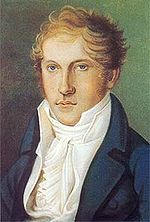Louis Spohr
Clarinet Concerto No.1 op 26
Clarinetist: Karl Leister
Orchestra: Radio Symphony Orchestra Stuttgart
Conductor: Rafael Frubeck de Burgos
The Clarinet Concerto No. 1 in C minor, Op. 26, was composed by Louis Spohr between fall of 1808 and early 1809, and published in 1812. The concerto was the first of four that Spohr would compose in his lifetime, all of which were dedicated to the German clarinet virtuoso Johann Simon Hermstedt.
Spohr was inspired to write the concerto after meeting Hermstedt in Sondershausen and performing the Mozart Clarinet Quintet with him, with Spohr playing the first violin part. Spohr began work on the Concerto No. 1 soon after, and finished it in January 1809. While Spohr was familiar with the range of the clarinet, he was not aware of its limitations and was willing to alter the score according to Hermstedt's advice. However, Hermstedt liked the score the way it was and decided to alter his own instrument to be able to play the piece. The result was an instrument with thirteen keys instead of the usual five.[1] Thus, the composition of the concerto could be seen as a driving factor in the clarinet's development throughout the 19th century.
The concerto was premiered by Hermstedt in June 1809 and was received with much enthusiasm. Allgemeine musikalische Zeitung, then the leading musical magazine in Germany, praised both the composer and the performer in its review:
‘As no composition whatever existed in which this excellent artist could display all the superiority of his playing, Herr Concertmeister Spohr of Gotha has written one for him; and, setting aside this special purpose, it belongs to the most spirited and beautiful music which this justly famous master has ever written.’[2]
Movements
- Adagio - Allegro (in C minor and sonata form, ends in C major)
- Adagio (in A-flat major and modified sonata form without development)
- Rondo (Vivace) (in C minor and in sonata rondo form) - The overall form is "First Subject in C minor - Secondary Subject in E-flat major - First Subject in C minor - Development in A-flat major - Secondary Subject in C major - First Subject in C minor - Coda in C minor". Unlike many classical works, the finale fades away in C minor, instead of ending with loud chords.
===========================================================================================================
Clarinet Concerto No.2 in E flat major Op.57
=================================================================
Clarinet Concerto No.3 in F minor 19
=================================================================
Clarinet Concerto No.4 E minor 20
=================================================================
슈포어 [Louis Spohr]본명은 Ludwig Spohr.( 1784.~ 1859./ 정조6년-철종10년,75세)
독일의 바이올린 연주자, 작곡가, 지휘자.
그의 작품은 독일 낭만주의 음악의 초기 단계를 보여준다.
슈포어는 모차르트의 악보를 연구하면서 독학으로 작곡을 공부했다. 브라운슈바이크 오케스트라 악장에게 바이올린을 배웠으며, 1802년에는 프란츠 에크로부터 배웠는데, 그는 슈포어를 러시아 여행에 데리고 갔다. 명(名) 바이올린 연주자 니콜로 파가니니와 이탈리아 연주여행을 했으며 1817년에는 프랑크푸르트 오페라단의 지휘자가 되었다. 1820년 첫 영국 연주여행을 했으며, 1821년 카셀 궁정 악단의 지휘자가 되었다. 말년에는 정치적으로 급진주의를 신봉하게 되어 후원자였던 헤센 카셀 선제후의 비위를 거슬리게 되었고, 1857년 해고당했다. 그후 얼마 지나지 않아 왼손이 부러지는 부상을 당해 바이올린을 연주할 수 없게 되었다.
그는 당대의 진보적인 작곡가들에게는 반대했지만(카를 마리아 폰 베버의 작품과 루트비히 판 베토벤의 후기작품을 싫어했음), 리하르트 바그너의 작품을 높이 평가했고, 〈방황하는 네덜란드인 The Flying Dutchman〉·〈탄호이저 Tannhäuser〉를 지휘했다. 그가 작곡한 11곡의 오페라 가운데 대표적인 것으로는 독일 낭만주의 오페라의 가장 초기작의 하나에 속하는 〈파우스트 Faust〉(1816)·〈예손다 Jessonda〉를 들 수 있다. 9곡의 교향곡 가운데 교향곡 4번 〈소리의 봉헌 Die Weihe der Töne〉이 가장 성공을 거두었다. 15곡의 바이올린 협주곡을 썼으며(이 가운데 8번은 지금도 연주됨) 34곡의 현악4중주, 4곡의 2중 현악4중주, 1곡의 9중주를 썼다. 1949년 이후 카셀에서 그의 작품 선집이 출판되었으며, 1954년 그곳에서 슈포어 음악을 기리기 위한 슈포어 협회가 결성되었다.(출처: 다음백과)
---------------------------------------------------------------------
Louis Spohr (5 April 1784 – 22 October 1859), born Ludwig Spohr, was a German composer, violinist and conductor. Highly regarded during his lifetime, Spohr composed ten symphonies, ten operas, eighteen violin concerti, four clarinet concerti, four oratorios and various works for small ensemble, chamber music and art songs.Spohr was the inventor of both the violin chinrest and the orchestral rehearsal mark. His output occupies a pivotal position between Classicism and Romanticism, but
fell into obscurity following his death, when his music was rarely heard. The late 20th century saw a revival of interest in his oeuvre, especially in Europe. ( 교향곡, 오페라 10곡/ 바이올린 협주곡 18곡/ 클라리넷협주곡 4곡/ 오라토리오 4곡외-) (출처: 영어위키백과)
'♣ 음악 감상실 ♣ > - 관악기' 카테고리의 다른 글
| Friedrich Witt (1770-1836): Flute Concerto in G Major op.8 (0) | 2015.07.27 |
|---|---|
| Peter von Winter - Flute Concerto No.2 in D-minor (0) | 2014.10.02 |
| Weber - Clarinet Concerto 1, 2번 (0) | 2014.09.04 |
| Franz Krommer - Clarinet Concerto for two clarinets in E-flat major, Op.35 / in E-flat major, Op.36 (0) | 2014.08.27 |
| 바로크 시대 스몰 풀륫 연주 모음(Baroque Works for a small Flute) (0) | 2014.08.24 |
